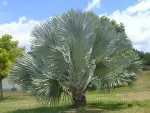This post contains affiliate links. If you buy something from one of our links we may earn a commission. Thanks
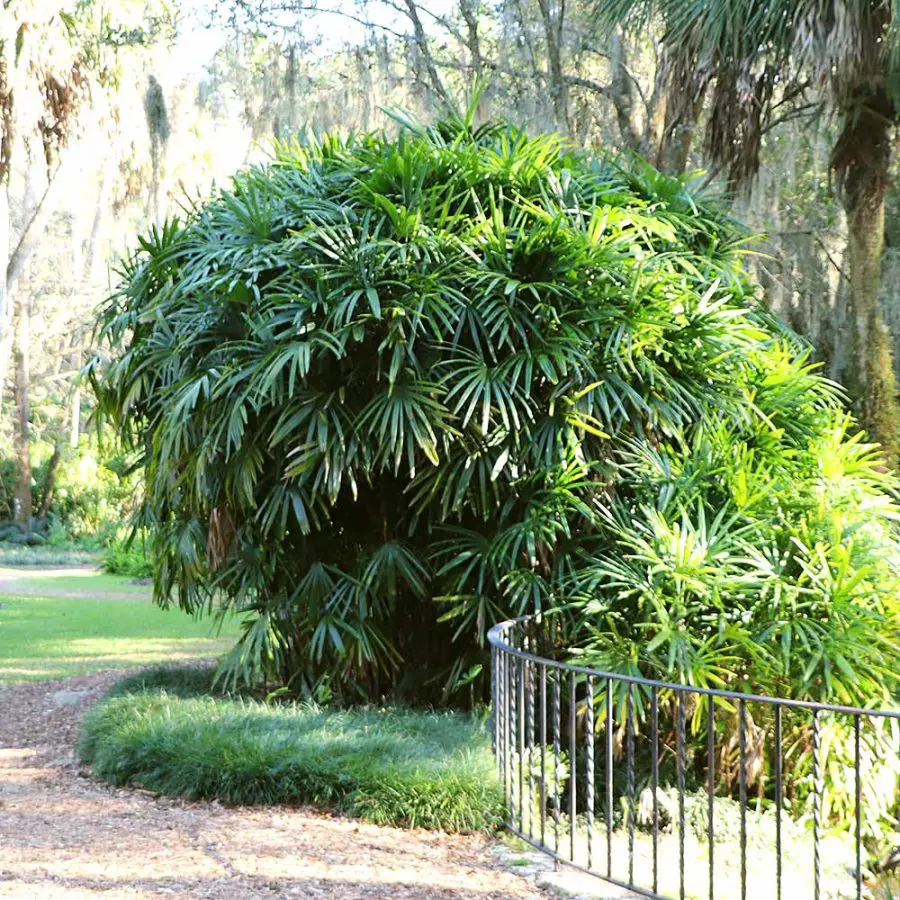
Want to know how to keep your Rhapis excelsa palm happy and healthy indoors? We’ve got you covered!
Rhapis Excelsa palm care primarily involves providing bright indirect light, consistent moisture without overwatering, and well-draining, nutrient-rich soil.
It’s essential to maintain a warm, humid environment, avoiding cold drafts and extreme temperatures. Regular inspection for pests and diseases, along with occasional fertilization using a balanced fertilizer or specialized palm fertilizer, further promotes healthy growth and longevity of the Rhapis Excelsa palm.
Our guide has everything you need to know, from watering to lighting and soil. It’s a must-read for any plant lover!
Are you looking for an indoor plant that’s both stylish and easy to care for? Look no further than the Rhapis excelsa or Lady palm!
This beautiful plant is a great choice for adding some tropical flair to your home or office.
And the best part? Rhapis excelsa palm care is a breeze!
With just a few simple tips and tricks, you can keep your palm looking lush and healthy for years to come.
So, let’s dive in and learn all about Rhapis excelsa palm care!
Rhapis Excelsa Palm Quick Facts
| Mature Height: | 5-7 ft Indoors 6-15 ft Outdoors |
| Mature Width: | 1-5 ft Indoors 5-10 ft Outdoors |
| Sunlight: | Full-Partial |
| Growth Rate: | Moderate |
| Botanical Name: | Rhapis Excelsa |
| Grows Well In Zones: | 4-11 patio / 9-11 outdoors |
You can buy your Rhapis Excelsa Lady Palm here
What Is A Rhapis Excelsa Palm?
Rhapis excelsa palm is known by several names, including Lady Palm, Broadleaf Lady Palm, Bamboo Palm, Miniature Fan Palm, and Ground Rattan Palm.
The common name can be confusing and sometimes wrong so when you buy this palm tree make sure it is labeled as Rhapis excelsa.
Why the Lady Palm is a popular indoor plant
The Rhapis palm is a popular indoor plant because of its beautiful appearance and easy care requirements.
These slow-growing plants are perfect to grow indoors in containers. Its lush green foliage and elegant form can add a touch of tropical elegance to any indoor space.
Its slow growth rate makes it perfect for those who want a low-maintenance plant.
It is also a great air-purifying plant, which means that it can help improve the air quality in your home or office by removing harmful toxins and pollutants from the air.
The benefits of having indoor plants
In addition to the Rhapis excelsa palm, there are many other indoor plants that offer a range of benefits.
For example, spider plants are great for removing formaldehyde and other toxins from the air, while aloe vera plants can help soothe sunburns and other skin irritations.
Having plants indoors can also help improve your mood and reduce stress levels, which can have a positive impact on your overall well-being.
So, whether you’re looking for a stylish new addition to your home decor or a way to improve your health and well-being, indoor plants are definitely worth considering!
Characteristics Of Rhapis Excelsa Palm
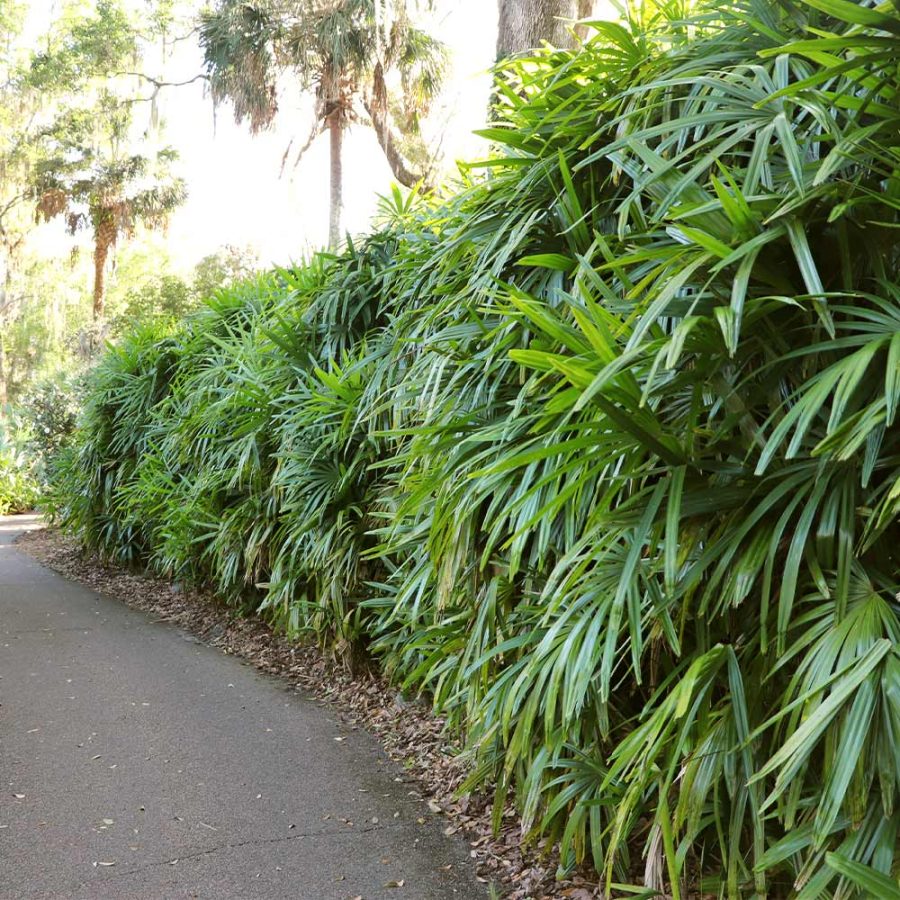
The Rhapis excelsa palm, also known as the Lady Palm, is a multi-stemmed plant that is characterized by its fan-like fronds and finger-like segments and bamboo-like trunks.
This palm is known for its slow growth rate, which makes it perfect for those who want a low-maintenance plant.
It can reach a height of up to six feet, but it typically stays smaller when grown indoors.
The Lady Palm is also prized for its air-purifying properties, which can help improve the quality of the air in your home or office.
In addition, this palm has a unique, textured appearance thanks to the brown, fibrous material that covers its stems.
All of these characteristics make the Rhapis excelsa palm a special and valuable addition to any indoor space.
In the next section, we’ll explore one of the most important factors in Rhapis excelsa palm care: light requirements.
Light Requirements
The Rhapis excelsa palm thrives in bright indirect light. This means that it should be placed in a location where it can receive plenty of light.
Too much hot direct sunlight can scorch the plant’s leaves and cause them to turn yellow or brown.
The best spot for your Rhapis excelsa palm is near a window that faces south or east.
This will allow it to receive bright, indirect light for most of the day.
You can use sheer curtains or blinds to filter the light and protect your plant from too much direct sunlight.
You can also use an LED grow light to supplement light even if you don’t have a good window for your Lady Palm.
If you notice that your palm’s leaves are turning yellow or brown, it may be receiving too much light.
On the other hand, if the leaves are a dull green color and the plant is not growing, it may not be receiving enough light.
In this case, you may need to move your plant to a brighter location or consider supplementing its light with a grow light.
Light Levels
The Rhapis excelsa palm is an incredibly low-maintenance indoor plant, making it a great option for those who are new to plant care or who don’t have a lot of time to devote to their greenery.
While this palm can tolerate a range of light conditions, it is happiest in low, dappled light without direct afternoon sun.
The Lady Palm Tree can grow well in both full sun or partial shade and even low-light conditions, but they will not tolerate hot midday sun or complete darkness.
Overall, this palm is a versatile and adaptable plant that can thrive in a variety of environments, as long as its basic needs are met.
This palm thrives in bright, indirect light. It is best to place the plant in a location where it can receive plenty of light.
Here are some tips to ensure your Rhapis excelsa palm receives the appropriate amount of light:
Find the right spot:
The best spot for your Rhapis excelsa palm is near a window that faces south or east. This will allow it to receive bright, indirect light for most of the day.
If your home doesn’t have a window that faces south or east, you can use sheer curtains or blinds to filter the light and protect your plant from too much direct sunlight.
Check the light conditions:
If you notice that your palm’s leaves are turning yellow or brown, it may be receiving too much light.
On the other hand, if the leaves are a dull green color and the plant is not growing, it may not be receiving enough light.
In this case, you may need to move your plant to a brighter location or consider supplementing its light with a grow light.
Rotate the plant:
To ensure that all sides of your palm receive enough light, rotate the plant every few weeks.
This will help prevent any one side from getting too much or too little light.
In the next section, we’ll explore another key aspect of Rhapis excelsa palm care: watering.
Watering And Humidity
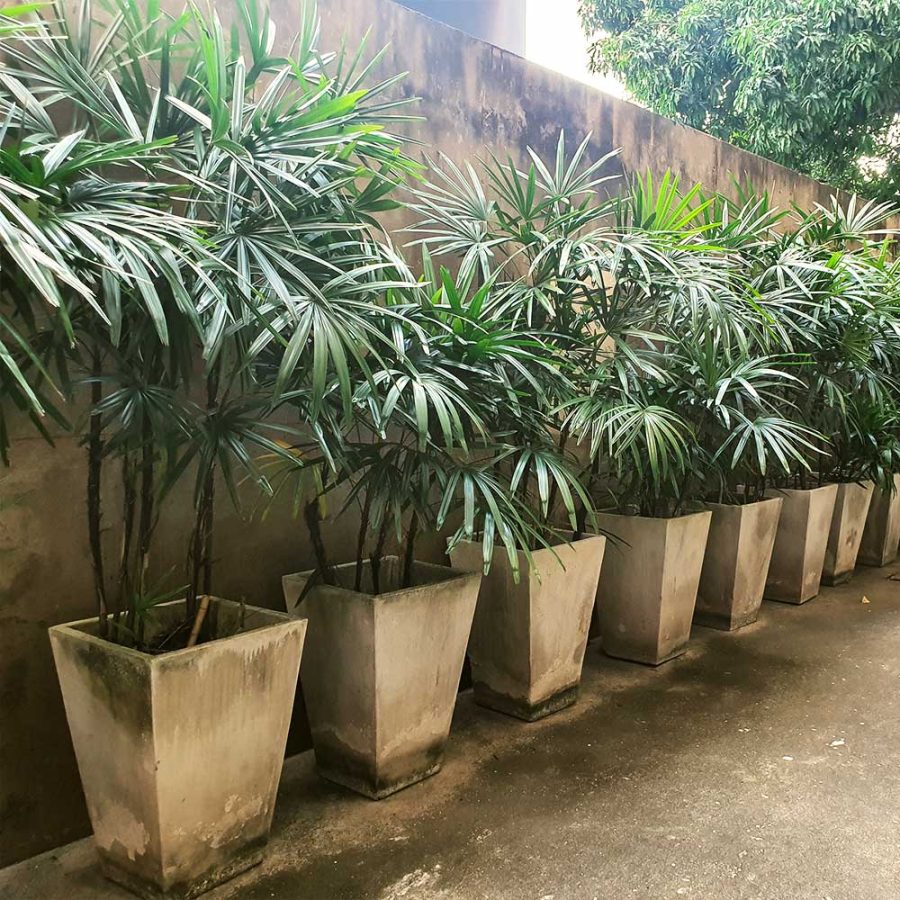
In addition to light, water, and humidity are two other essential factors in caring for your Rhapis excelsa palm.
While this plant is generally easy to care for, it does have some specific requirements when it comes to watering and humidity levels.
In this section, we’ll discuss how to water your Lady Palm, how often to do it, and how to maintain the right levels of humidity to keep your plant healthy and happy.
Watering
The Rhapis excelsa palm is a tropical plant that requires consistent moisture, but it’s important not to overwater it.
Overwatering can lead to root rot and other issues. Here are some tips for watering your Rhapis excelsa palm:
Check the soil: Before watering your plant, check the soil with your finger. If the top inch of soil feels dry, it’s time to water.
Use the right water: These palms are sensitive to minerals and chemicals in tap water, so it’s best to use distilled or filtered water.
If you don’t have access to distilled or filtered water, you can use rainwater.
The old suggestion of letting tap water sit out overnight before using it to water your plant does not work.
Unlike chlorine chemicals like chloramines in the water won’t evaporate.
Water thoroughly: When you water your Rhapis excelsa palm, be sure to water it thoroughly until the water drains out of the bottom of the pot.
Make sure to remove any excess water from the saucer. This will ensure that the roots are getting enough water and help prevent the soil’s buildup of salts.
Don’t overwater: Overwatering is one of the most common mistakes people make when caring for Rhapis excelsa palms.
Be sure to let the soil dry out slightly between waterings to prevent root rot.
Humidity
Lady Palms are tropical plants that thrive in humid environments. Dry air can cause the plant’s leaves to turn brown and dry out.
Here are some tips for maintaining appropriate humidity levels for your Rhapis excelsa palm:
• Group plants together:
Placing your Rhapis excelsa palm near other plants can help increase the humidity in the air.
• Use a pebble tray:
Place your palm tree on a pebble tray. A pebble tray contains pebbles that are kept partially submerged in water.
It is not used for watering but for adding humidity.
• Use a humidifier:
If you live in a dry climate or your home has low humidity levels, consider using a humidifier to add moisture to the air.
• Mist the leaves:
Misting the leaves of your Rhapis excelsa palm with a spray bottle can help increase the humidity in the immediate area around the plant.
By following these tips, you can ensure that your palm tree receives the proper amount of water and humidity to thrive.
In the next section, we’ll discuss temperature and ventlation for your plant to promote healthy growth.
Temperature And Air Circulation
In addition to light, water, and humidity, temperature and air circulation are important factors to consider when caring for your Rhapis excelsa palm.
These plants are tropical in origin and thrive in warm, humid environments.
In this section, we’ll discuss the optimal temperature range for Rhapis excelsa palms and how to ensure proper air circulation to keep your plant healthy and happy.
Temperature
Rhapis excelsa palms are tropical plants that thrive in warm, humid environments. Ideally, the temperature range should be between 65-85°F (18-29°C).
Avoid exposing your palm tree to temperatures below 50°F (10°C) or cold drafts, as this can damage the leaves and cause the plant to suffer.
Suitable environment
To maintain the optimal temperature range, consider the placement of your Rhapis excelsa palm.
Avoid placing it near drafty areas, such as near doors, heating vents, or windows that are frequently opened.
Keep the plant away from air conditioning vents or heaters, as this can cause the plant to dry out quickly.
Placing the plant in a well-insulated room with consistent temperatures is ideal.
Air circulation
Proper air circulation is important to prevent the buildup of stagnant air, which can lead to a variety of issues such as fungal growth and pest infestations.
Here are some tips for achieving adequate air circulation:
Use a fan: A small oscillating fan can help improve air circulation around your Rhapis excelsa palm. Be sure to set it on a low or medium speed to avoid causing too much air movement.
Open windows: On mild days, opening a window can help improve air circulation in your home.
Clean the leaves: Dust and debris can accumulate on the leaves of your Rhapis excelsa palm, hindering the plant’s ability to absorb sunlight and moisture.
Wiping the leaves with a damp cloth or using a plant-safe cleaning spray can help improve air circulation.
By following these tips, you can ensure that your Lady Palm is in an environment with the proper temperature and adequate air circulation to thrive.
In the next section, we’ll discuss soil and how to fertilize your plant to promote healthy growth.
Soil And Fertilization
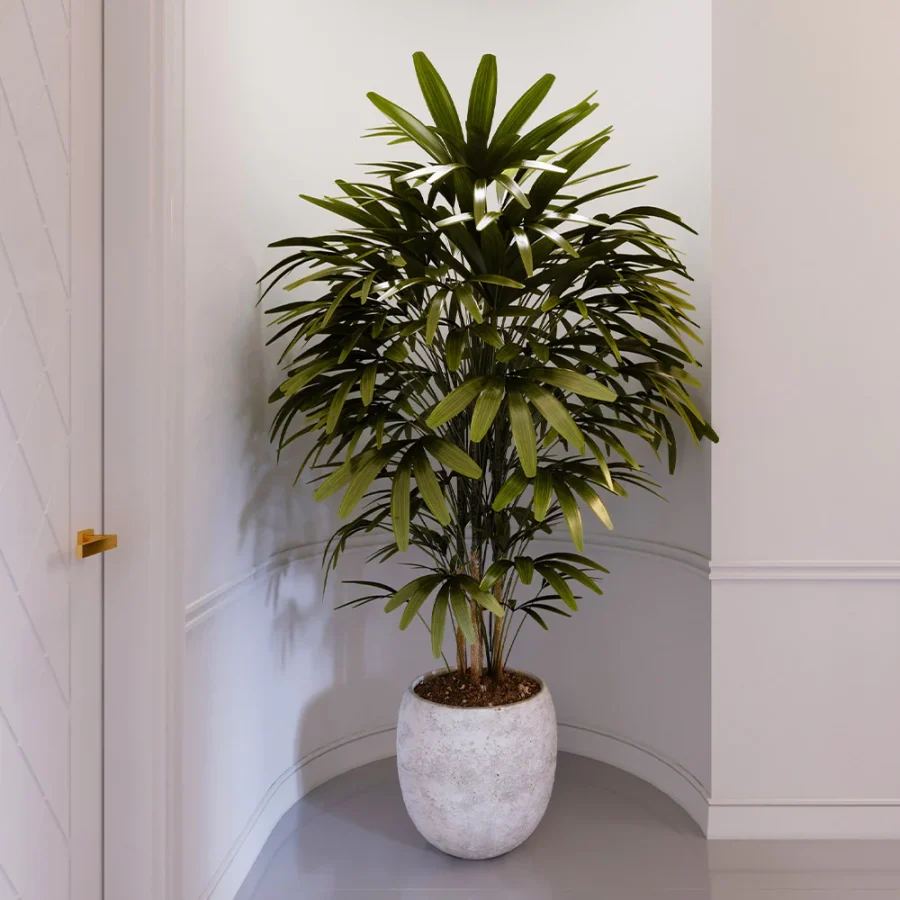
The right soil and proper fertilization are essential for the health and growth of your Rhapis excelsa palm.
In this section, we’ll discuss the soil requirements for this plant, as well as the best fertilization techniques to promote healthy growth.
By ensuring that your Rhapis palm has the right soil and nutrients, you can help it thrive and maintain its lush, vibrant appearance.
Soil
Rhapis excelsa palms prefer well-draining soil that is rich in organic matter.
A good potting mix should be light and airy, allowing water to drain easily.
Coco coir is an excellent choice for all palm trees, as it is more sustainable and environmentally friendly than traditional peat moss.
Unlike peat moss, which is extracted from bogs and takes a long time to regenerate, coco coir is made from coconut husks, which are a renewable resource.
Coco coir also has excellent water retention properties and is naturally resistant to pests and diseases.
Make sure your soil has good drainage and make sure the pot you use has drainage holes.
Fertilization
Rhapis excelsa palms do not require frequent fertilization, but they do benefit from occasional feeding.
Fertilizing your plant every two to three months during the growing season can promote healthy growth and vibrant foliage.
Choose a balanced, water-soluble fertilizer with equal parts nitrogen, phosphorus, and potassium.
Alternatively, you can use a specialized palm fertilizer, which contains extra micronutrients such as magnesium and manganese that are essential for healthy growth.
When fertilizing your Rhapis excelsa palm, be sure to follow the manufacturer’s instructions carefully, as over-fertilization can damage the plant’s roots and cause burning of the leaves.
The use of tree spikes will take the guesswork out of fertilizing. Here is what I recommend for  fertilizing your Lady Palm.
fertilizing your Lady Palm.
I recommend using Jobes Organics fertilizer spikes.
They are easy to use and last for 2-3 months.
They are designed for container-grown citrus but they work great for palm trees too.
Using 2 spikes for a 12-inch pot or 3 for an 18-inch pot takes the guesswork out of fertilizing.
They provide a 3-5-5 fertilizer blend along with micronutrients and beneficial bacteria.
It’s also important to ensure that the soil is moist before fertilizing to avoid salt buildup and ensure that the nutrients are absorbed properly.
By using the right soil and fertilizing your Rhapis excelsa palm appropriately, you can help ensure that it remains healthy and vibrant.
Pot Size And Repotting

Rhapis excelsa palms are a slow grower and typically require repotting only once every two to three years.
When selecting a pot, choose one that is only slightly larger than the plant’s current container.
The pot should have drainage holes to prevent water from accumulating in the soil.
When it’s time to repot, gently remove the plant from its current container, being careful not to damage the roots.
Inspect the roots for any signs of damage or disease and trim away any dead or rotten roots.
Fill the new pot with fresh potting soil and place the plant in the center, making sure the soil level is even with the top of the root ball.
Water the plant thoroughly and place it in a location with appropriate light and humidity.
It’s important not to over-pot your Rhapis excelsa palm, as this can lead to waterlogged soil and an increased risk of root rot.
As a general rule, the pot should be no more than one to two inches larger in diameter than the previous container.
In the next section, we’ll discuss how to propagate your plant to expand your indoor garden.
Propagation
Propagating your Rhapis excelsa palm is a great way to expand your indoor garden without having to purchase new plants.
There are two main methods of propagating Rhapis excelsa palms: division and seed propagation.
Division involves separating the plant’s root system into smaller sections, each of which can be potted and grown as a separate plant.
To divide your Rhapis excelsa palm, carefully remove it from its pot and gently separate the root ball into smaller sections, making sure each section has several healthy stems and a good root system.
Re-pot each section in a new pot with fresh potting mix and water it thoroughly.
It’s important to avoid disturbing the plant too much during the division process, as this can cause stress and damage.
Propagation From Rhizome Offshoots
Propagating a Rhapis excelsa palm is a breeze, thanks to its rhizome root system.
To expand your plant collection, take a cutting from the base of your palm and pot it up.
It’s best to select rhizome offshoots that have already grown some roots and plant them in a small pot with a quality soil mix.
This will give the new plant the nutrients it needs to thrive.
Propagating From Seeds
Seed propagation is a more time-consuming method of propagation, but it can be rewarding to watch your plant grow from a tiny seedling.
To propagate your Rhapis excelsa palm from seeds, start by selecting fresh, healthy seeds from a mature plant.
Soak the seeds in water for a few hours to soften the outer shell, then plant them in a pot filled with fresh potting mix.
Cover the pot with plastic wrap or a plastic bag to create a mini greenhouse, and keep the soil moist until the seeds germinate.
This can take several weeks, so be patient and continue to care for the seedlings as they grow.
 If you don’t have a plant that is making seeds you may be able to find them online.
If you don’t have a plant that is making seeds you may be able to find them online.
Whether you choose to propagate your Rhapis excelsa palm through division or seed propagation, be sure to provide your new plants with the same care and attention as the parent plant to ensure their health and vitality.
With a bit of patience and care, you can expand your indoor garden and enjoy the beauty of these elegant, low-maintenance palms.
Common Problems And Solutions
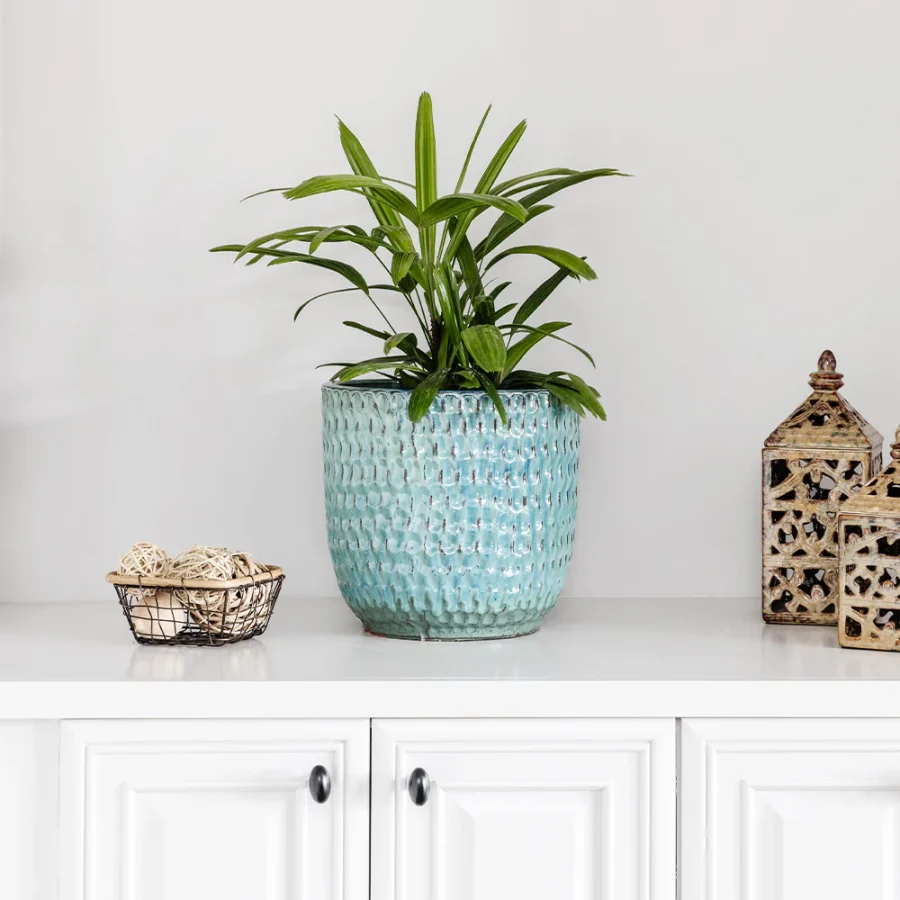
While Rhapis excelsa palms are generally easy to care for, they can still be susceptible to a few common problems.
From pests to diseases to environmental factors, there are a number of issues that can affect the health and appearance of your plant.
Fortunately, many of these problems are easily preventable or treatable with the right care and attention.
In this section, we’ll explore some of the most common problems that Rhapis excelsa palms can face, and offer tips and solutions for keeping your plant healthy and thriving.
Common insect pests and treatment
Some common insect pests that can affect Rhapis excelsa palms include spider mites, mealybugs, and scale insects.
If you notice any signs of infestation, such as webs, sticky residue, or visible bugs on your plant, it’s important to take action to prevent the pests from causing damage.
One treatment option is to use insecticidal soap, which is a natural and effective way to control pests.
You can buy pre-made insecticidal soap or make your own by mixing mild dish soap with water.
Be sure to follow the instructions on the product carefully and apply the soap thoroughly to all parts of the plant, including the undersides of the leaves.
It is important to spray the entire plant.
Another treatment option is to introduce beneficial insects, such as ladybugs or lacewings, which can help control pest populations without the use of chemicals.
You can purchase beneficial insects online or at garden centers and release them into your plant’s environment.
Neem oil is another effective treatment for insect pests that may affect Rhapis excelsa palms.
Neem oil is a natural insecticide that works by disrupting the life cycle of pests and preventing them from reproducing.
To use neem oil, dilute it with water according to the instructions on the product and apply it to your plant using a spray bottle or other applicator.
Be sure to apply the oil thoroughly to all parts of the plant, including the undersides of the leaves.
It’s important to note that neem oil can be harmful to beneficial insects, such as bees and ladybugs, so use it with caution and avoid applying it during times when beneficial insects are active.
As with any treatment method, it’s important to follow the instructions on the product carefully and monitor your plant for any adverse effects.
If you have any concerns or questions, it’s always a good idea to consult with a gardening expert or plant care professional.
Regularly inspecting your plant for signs of infestation and taking action at the first sign of a problem is key to keeping your Rhapis excelsa palm healthy and pest-free.
Diseases
Rhapis excelsa palms are generally hardy and disease-resistant, but they can be susceptible to root rot, which is caused by overwatering and poor drainage.
This fungal disease can cause yellowing leaves, stunted growth, and root decay.
To prevent root rot, be sure to use well-draining soil and allow the soil to dry out slightly between waterings.
Other diseases that can affect Rhapis palms include leaf spot, which is caused by a fungal or bacterial infection.
By being vigilant and taking proactive steps to prevent and address any disease problems that may arise, you can help ensure that your Rhapis excelsa palm remains healthy and beautiful for years to come.
Rhapis Excelsa FAQs
Caring for a Rhapis Excelsa palm requires a certain level of understanding to ensure that the plant thrives in your indoor space.
Many plant enthusiasts have common inquiries regarding the essential aspects of nurturing this elegant palm.
Below, we have compiled a list of frequently asked questions (FAQs) to provide insights into the care, maintenance, and propagation of Rhapis Excelsa palm.
These answers aim to equip you with the knowledge needed to enjoy the beauty and benefits of this tropical plant in your home or office.
Q. What is the ideal temperature range for Rhapis Excelsa palm?
A. The ideal temperature range for Rhapis Excelsa palm is between 65-85°F (18-29°C). Avoid exposing the plant to temperatures below 50°F (10°C) or to cold drafts as they can cause leaf damage.
Q. How often should I water my Rhapis Excelsa palm?
A. Watering frequency depends on the humidity and the potting medium’s moisture retention capacity. It’s vital to let the top inch of soil dry out before watering again. Overwatering can lead to root rot, which is a common issue with these palms.
Q. What type of soil is best for Rhapis Excelsa palm?
A. Rhapis Excelsa palm thrives in well-draining soil rich in organic matter. A mixture containing coco coir, which is light, airy, and allows for good drainage, is an excellent choice for these palms.
Q. How do I propagate Rhapis Excelsa palm?
A. Propagation can be done through division or from seeds. Division involves separating the root ball into smaller sections, each with several healthy stems and roots, then repotting them. Seed propagation requires planting fresh seeds from a mature plant in a suitable potting mix and maintaining a moist, warm environment until germination occurs.
Rhapis Excelsa Palm Care Final Thoughts
Congratulations, you’ve made it to the end of this guide on Rhapis excelsa palm care!
By now, you should have a good understanding of the key factors that contribute to the health and well-being of this popular indoor plant.
Throughout this guide, we’ve covered everything you need to know about caring for a Rhapis excelsa palm.
We’ve discussed the plant’s light requirements, how to properly water and maintain humidity levels, and the ideal temperature and air circulation conditions for this tropical plant.
We’ve also talked about the appropriate soil and fertilization needs for Rhapis excelsa palms, as well as tips for propagating your plant and troubleshooting common issues that may arise.
If you’re considering adding a Rhapis excelsa palm to your indoor plant collection, we highly encourage you to do so!
This plant is not only aesthetically pleasing but also comes with many health benefits, such as purifying the air and promoting relaxation.
With the information provided in this guide, you should have the tools and knowledge to care for your new plant and help it thrive in your home or office.
So go ahead and add a Rhapis excelsa palm to your collection today!
You can buy your Rhapis Excelsa Lady Palm here
Learn more about Indoor Palm Tree Care with our Complete Guide For Beginners



